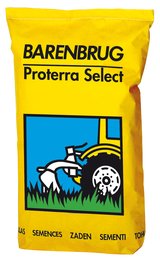Proterra Select provides more organic matter in soil
As a result of the stricter manure and irrigation regulations, crop yields will decline sharply in the future, by as much as 30%, particularly on sandy soil and to a slightly lesser extent on loess and clay soils. Adjustments in the cropping plan, tillage and fertilisation may constrain these lower yields.
One percent higher organic matter content provides an extra €155 per ha, due to better nitrogen supply (+€25), extra moisture supplying capacity to the plant (+€80) and a higher yield from the main crop (+€50). This data was taken from a study conducted by Wageningen University & Research (WUR) and the Nutrient Management Institute (NMI).
Proterra Select increases organic matter content by means of intensive root growth in the uppermost layer of the top soil and above-ground growth of the plant. This improves the structure of the soil.
Simultaneous sowing with winter wheat
Sowing Proterra Select in one pass with winter wheat yields clear cost savings. The success rate of this method is very high. Proterra Select does not undergo any significant development before the winter. Moreover, Proterra Select is less sensitive to vernalisation, which means that virtually no seed stalks are formed, especially when sowing from mid-October.
Unique resistance to crop protection products
Weed control can be carried out after sowing. The varieties in Proterra Select are specially selected with regard to their high tolerance to all common crop protection products in winter wheat. Extensive annual field trials have also demonstrated this. As a result, green manure develops extremely well in spite of weed control.
Immediately after the wheat harvest, the 'greening' process starts and the grass green manure develops smoothly when there is sufficient moisture. Both below and above ground.
High disease and drought resistance
A high resistance to disease is important because it is only sown under cover crops. As a result, the grass plants receive considerably less light and the humidity is higher, which increases the disease pressure. By using red fescue with a high disease resistance, the crop grows well after the harvest of the winter wheat. In addition, Proterra Select is free of quackgrass and blackgrass so that soil is not contaminated with unwanted weeds. In the summers of 2018-2019, Proterra Select also proved to be highly resistant to drought. The crop survived the drought very well and grew after the first rainfall.
Proterra Select can be sown together with winter wheat from early October to early December. Preference is given to wide-spread sowing at the same time as wheat sowing. Seed quantity: 15-20 kg Proterra Select.
Proterra Select complies with the greening requirements in several countries as sowing under cover crops. The advantage is that this makes it easier for you to comply with the regulations.



